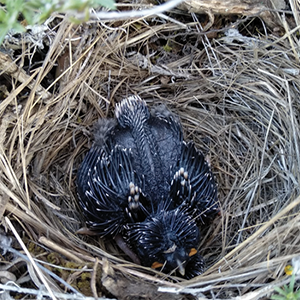First documented case of Tawny Pipit Anthus campestris nest parasitism by common cuckoo Cuculus canorus in Spanish steppes

Submitted: 8 June 2022
Accepted: 6 September 2022
Published: 19 December 2022
Accepted: 6 September 2022
Abstract Views: 1240
PDF: 251
Publisher's note
All claims expressed in this article are solely those of the authors and do not necessarily represent those of their affiliated organizations, or those of the publisher, the editors and the reviewers. Any product that may be evaluated in this article or claim that may be made by its manufacturer is not guaranteed or endorsed by the publisher.
All claims expressed in this article are solely those of the authors and do not necessarily represent those of their affiliated organizations, or those of the publisher, the editors and the reviewers. Any product that may be evaluated in this article or claim that may be made by its manufacturer is not guaranteed or endorsed by the publisher.
Similar Articles
- Mauro Mencarelli, Niki Morganti, Project of the avifauna near Senigallia: the Misa River. First year of survey , Rivista Italiana di Ornitologia: Vol. 82 No. 1-2 (2012)
- Niki Morganti, Francesca Portavia, Observation on a colony of Bee-eater, Merops apiaster, in Marche Region , Rivista Italiana di Ornitologia: Vol. 82 No. 1-2 (2012)
- Davide De Rosa, Ilaria Fozzi, Alberto Fozzi, Mauro Sanna, Jan Škrábal, Rainer Raab, Benedetta Catiti, Andrea Rotta, Ivan Literák , Fiammetta Berlinguer, Mauro Aresu, A vanishing raptor in a Mediterranean island: an updated picture of Red kite (Milvus milvus) in Sardinia, Italy , Rivista Italiana di Ornitologia: Vol. 91 No. 1 (2021)
- Jean-Claude Thibault, Christian Frelin, Nathalie Legrand, Ludovic Lepori, Antoine Rossi, Alice Cibois, Distribution and characteristics of urban nesting sites of sympatric swifts , Rivista Italiana di Ornitologia: Vol. 93 No. 1 (2023)
- Luca Puglisi, Enrico Meschini, Paolo Sposimo, Common bird monitoring in Tuscany , Rivista Italiana di Ornitologia: Vol. 82 No. 1-2 (2012)
- Tommaso La Mantia, The Breeding Birds of Malta , Rivista Italiana di Ornitologia: Vol. 81 No. 2 (2011)
- Fabio Casale, Ettore Rigamonti, Marco Ricci, Luca Bergamaschi, Raffaele Cennamo, Angelo Garanzini, Leonardo Mostini, Alessandro Re, Valentina Toninelli, Mauro Fasola, Gli uccelli della provincia di Novara (Piemonte, Italia): distribuzione, abbondanza e stato di conservazione , Rivista Italiana di Ornitologia: Vol. 87 No. 1 (2017)
- Paolo Pedrini, Alessandro Franzoi, Paula Lorenzo Sanchez, Fernando Spina, Simone Tenan, Francesca Rossi, Marco Bandini, Giampiero Calvi, Franco Colnago, Giuditta Corno, Stefano Noselli, Maffeo Schiavi, Severino Vitulano, Daniele Accantelli, Fulvio Barbarino, Roberto Bertoli, Enrico Borgo, Redi Dendena, Sergio Fasano, Andrea Favaretto, Andrea Galimberti, Rocco Leo, Mariella Nicastro, Marco Pavia, Iacun Prugger, Domenico Rosselli, Alberto Tamietti, Enrico Viganò, Lorenzo Serra, [Transiting species, phenologies and their trends] , Rivista Italiana di Ornitologia: Vol. 91 No. 2 (2021)
- Marco Dinetti, The sparrow project of lipu/birdlife Italy , Rivista Italiana di Ornitologia: Vol. 82 No. 1-2 (2012)
- Paolo Giacchini, Federico Fanesi, Massimo Prosdocimi, The pygmy cormorant Microcarbo pygmaeus in central Italy: the status in the Marche region and the first confirmed breeding record in the province of Pesaro e Urbino (PU) , Rivista Italiana di Ornitologia: Vol. 92 No. 2 (2022)
<< < 3 4 5 6 7 8 9 10 11 12 > >>
You may also start an advanced similarity search for this article.


 https://doi.org/10.4081/rio.2022.634
https://doi.org/10.4081/rio.2022.634




